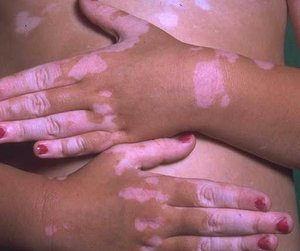Vitiligo
Vitiligo (IPA /ˌvɪtəˈlaɪgo/) or leukoderma is the patchy loss of skin pigmentation due to an auto-immune attack by the body's own immune system on skin melanocytes. It frequently begins in late adulthood, with patches of unpigmented skin appearing on extremities. The patches may grow or remain constant in size. Occasional small areas may repigment as they are recolonised by melanocytes. The population incidence is between 1% and 2%. more...
Vitiligo is not contagious.
In some cases, mild trauma to an area of skin seems to cause new patches - for example around the ankles (caused by friction with shoes or sneakers). Vitiligo may also be caused by stress that affects the immune system, leading the body to react and start eliminating skin pigment.
The disease is not medically a problem, but it is mentally and socially to some people, other than the problem that the affected skin areas have no protection against sunlight - they burn but never tan. However, if the skin is naturally dark, the visual effect of the white patches may be considered disfiguring by some. (If the affected person is pale-skinned, the patches can be at least be made less visible by avoiding sunlight and the tanning of unaffected skin.) The location of vitiligo affected skin changes over time, with some patches re-pigmenting and others becoming affected. (Exposure to sunlight is always better; it helps the melanocytes regenerate to allow the pigmentation to come back to its original color.)
Vitiligo on the scalp may affect the colour of the hair (though not always), leaving white patches or streaks. It will similarly affect whiskers and body hair.
In some cultures there is a stigma attached to having vitiligo. Those affected with the condition are sometimes thought to be evil or diseased and are sometimes shunned by others in the community. People with vitiligo may feel depressed because of this stigma or because the way their skin looks is a dramatic change.
Treatment
Steroids have been used to remove the white patches, but they are not very effective. Other more dramatic treatments include chemically treating the patient to remove all pigment from the skin to present a uniform skin tone. Current experimental treatments include exposure to narrow-band UV light, which seems to blur the edges of patches, and lightly freckling the affected areas. Immunomodulator creams are believed to cause repigmentation in some cases, but there is no scientific study yet to back this claim. All these treatments alter the appearance but do not address the underlying cause of vitiligo.
In late October of 2004, doctors successfully transplanted melanocytes to vitiligo affected areas, effectively repigmenting the region. The procedure involved taking a thin layer of normally pigmented skin from the patient's "gluteal region". Melanocytes were then separated out and used to make a cellular suspension. The area to be treated was then ablated with a laser, and the melanocyte graft applied. Three weeks later, the area was exposed to UV light repeatedly for two months. Between 73 and 84 percent of patients experienced nearly complete repigmentation of their skin. The longevity of the repigmentation differed from patient to patient.
Read more at Wikipedia.org




